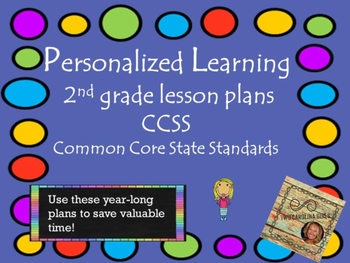Personalized Learning Second Grade Lesson Plans CCSS
Two Carolina Girls
152 Followers
Grade Levels
2nd, Homeschool
Subjects
Resource Type
Standards
CCSS2.MD.A.1
CCSS2.MD.A.2
CCSS2.MD.A.3
CCSS2.MD.A.4
CCSS2.MD.B.5
Formats Included
- PDF
Pages
13 pages
Two Carolina Girls
152 Followers
Description
Personal Mastery is a learner-centered, standards based educational approach which leads to each student mastering learning in a personalized manner. It adheres to a customized learning and performance and competency based education. In a Personal Mastery classroom, personalizing learning is the process which empowers the learner, with appropriate support and advice, to decide what, where, when and how they learn. This is achieved by developing the engagement of learners in the management and design of their learning experiences.
Because each student is pre-assessed, scored and then begins instruction on their level it no longer makes sense to use traditional lesson plans. The teacher no longer provides whole group instruction where every student is working on the same page on the same day.
These lesson plans cover all the standards for each subject for the entire school year. I print them out and make them available for parents, administration and other classroom observations. I then make quick notes for myself for my small group instruction as needed. These are not traditional small groups, but groups pulled on an as needed basis. They consist of review, re-teach or enrichment groups.
Because each student is pre-assessed, scored and then begins instruction on their level it no longer makes sense to use traditional lesson plans. The teacher no longer provides whole group instruction where every student is working on the same page on the same day.
These lesson plans cover all the standards for each subject for the entire school year. I print them out and make them available for parents, administration and other classroom observations. I then make quick notes for myself for my small group instruction as needed. These are not traditional small groups, but groups pulled on an as needed basis. They consist of review, re-teach or enrichment groups.
Total Pages
13 pages
Answer Key
N/A
Teaching Duration
1 Year
Last updated Jul 30th, 2016
Report this resource to TPT
Reported resources will be reviewed by our team. Report this resource to let us know if this resource violates TPT’s content guidelines.
Standards
to see state-specific standards (only available in the US).
CCSS2.MD.A.1
Measure the length of an object by selecting and using appropriate tools such as rulers, yardsticks, meter sticks, and measuring tapes.
CCSS2.MD.A.2
Measure the length of an object twice, using length units of different lengths for the two measurements; describe how the two measurements relate to the size of the unit chosen.
CCSS2.MD.A.3
Estimate lengths using units of inches, feet, centimeters, and meters.
CCSS2.MD.A.4
Measure to determine how much longer one object is than another, expressing the length difference in terms of a standard length unit.
CCSS2.MD.B.5
Use addition and subtraction within 100 to solve word problems involving lengths that are given in the same units, e.g., by using drawings (such as drawings of rulers) and equations with a symbol for the unknown number to represent the problem.





